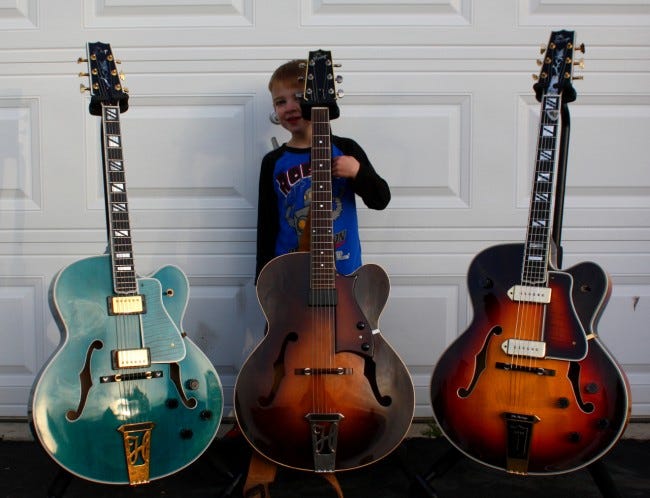Turn Up The Eagles, The Neighbors Are Listening

Two weeks ago, the Doctor and I cut a deal in which I traded two Heritage guitars for a Super Eagle jazzbox. The trade wasn't problem-free; the natural-finish 157 arrived at his house with a few leather-strap-induced "nitro burns" on the finish which I had rectified by his local luthier.
Despite that minor problem, we were both satisfied enough with the trade to try it a second time. Two more guitars from me, one back from him, and another damage issue --- but this time it was serious.
Yup, that's a crack, caused by the decision of someone at UPS to drop the box hard. I packed it to survive the Apocalypse but it didn't survive the brown-van crew. Incidentally, this is at least the third time UPS has broken a guitar for the Doctor. It's never happened to me. We're pursuing a claim with UPS, and once again his local guy is willing to fix it. It's a shame, because that H-157 is a monster: it was Floyd-sprayed and features hand-wound "HRW" pickups by Heritage founder Ren Wall.
The other guitar I traded him was an H-555 that Heritage displayed at the 2008 NAMM show; it was cherry-red and absolutely perfect. The two axes together were worth a fair amount of money and I expected something spectacular in return. I'll let the Doctor describe it:
To my knowledge, there were four Super Eagles with P90s made. One was an almond sunburst with cream P90s. [Another collector]'s looks like mine only smaller and without the master volume. I don't know about the third. The full bodied Super Eagle (deeper than 3") is a major upgrade in terms of cost. The only other guitar that Heritage makes with that depth is the Henry Johnson.
Mine was ordered by a working jazz player in NYC in the 1990s with the body dimensions of the Super 400 and with the pups that were on the Super 400 in the mid 1950s. He played chord melody at times and wanted a slightly wider nut. The master volume was practical for two reasons. It worked to maintain the pickup blend while adjusting the overall volume. Also, it acted as a kill switch. He dialed it off between songs.
RS Guitarworks devised and created a harness that uses a superpot that minimizes treble roll off when reducing the volume. Actually all of the pots in the harness are "superpots", but the resistances are set up especially to make the master volume work as it theoretically should. This is the first time RS Guitarworks did this, and they put quite a bit of time into it.
The nut is 1 3/4". So it is like a Johnny Smith with a slightly longer 25.5" scale.
Let's see the picture! In this one, we have, left to right: the Chinery Blue Super Eagle, my Spruce Eagle which was re-necked by Aaron Cowles, and the newest addition, the Sunset Burst Super Eagle P-90:

Looks like we have a guest star there, as well! Three pretty decent jazzboxes, if I do say so myself. There's nothing quite as gloriously unnecessary as an eighteen-inch-bodied electric jazz guitar. The original jazz guitars were sixteen inches, like the Eagle in the center. The 17" and 18" so-called "advanced" guitars were an attempt to make the guitar audible in a big band before the popular advent of amplification. (For an example of an acoustic 18" guitar with no cutaway, check out this early Super 400 at Elderly. By all rights, they should have immediately died once it became possible to plug in... but some people continued to want the very best, and the eighteen-inch archtop is the very best. Whether it's a Gibson Super 400, a Freddie Green-style Stromberg Master 400, an original Epiphone Emperor, or a Heritage Super Eagle, the eighteen-inch archtop is a glorious throwback to a very short and very brilliant era. I'm looking forward to having these archtops in my collection for years to come.
The phrase "Turn Up The Eagles, The Neighbors Are Listening" appears in the Steely Dan song, "Everything You Did". The Eagles repaid the favor a year later in Hotel California with a reference to "steely knives just can't kill the beast".

